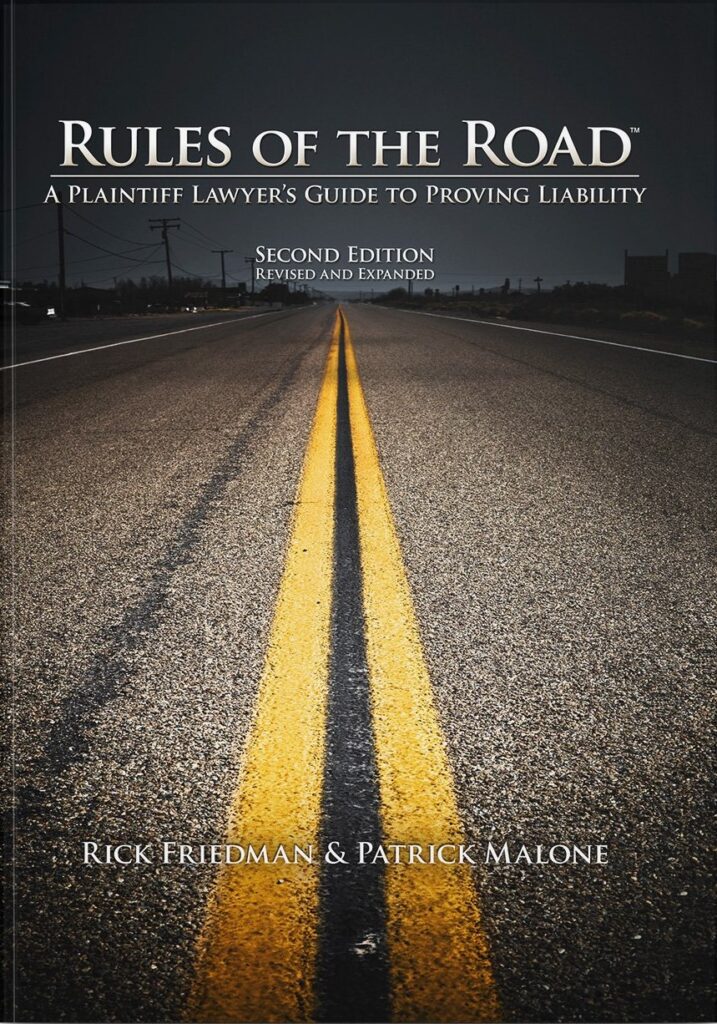A must read for any practicing trial attorney – Rules of the Road: a Plaintiff Lawyer’s Guide to Proving Liability, takes the reader on a journey from the initial filing of the complaint to discovery, to the use of experts and of documents in preparation for trial, and then into the crucial techniques necessary to win any trial, all while using the Rules of the Road.
Rules of the Road is America’s bestselling text on proving liability. Since it hit the shelves in 2006, it has helped lawyers across the country win six, seven, and eight-figure verdicts in cases with difficult liability. The book is the basis of an American Association for Justice Trial College, the topic of many CLE lectures by the country’s leading trial lawyers, and is also taught in trial advocacy classes in law schools. The book provides numerous examples and explanations that come straight from actual briefs, depositions, and trial transcripts. These examples illustrate how these principles work, all while simultaneously leaving the reader to adapt the concepts they learn to their own cases.
So, what are the Rules of the Road?
At its most basic level, the Rules of the Road is a technique used to educate first the trial lawyer, and then the judge and the jury, about the basic principles of the case that require the dispute to be resolved based on obligations the defendant has violated and for which it should be held accountable.
As lawyers, we venture into complex fields of human endeavor – engineering, architecture, insurance – and we ask the jury to follow us there. Each of these fields have numerous complex standards, customs, rules, principles, and regulations that are not known or even understood by the average person. It’s the plaintiff attorney’s job to break down the complex principles in a case into digestible and easy to understand concepts for the jury. By doing this, plaintiff lawyers can defeat the three weapons every defense lawyer uses to try and beat a plaintiff’s case: complexity, confusion, and ambiguity.
The book creates a formula for constructing “rules” – meaning principles that cannot be disputed, even by opposing counsel and their witnesses – that are broken down into bite-sized, digestible pieces of information that any juror can understand regardless of their prior background. These rules can create the roadmap to lead any plaintiff’s attorney to the road of victory. Rich Friedman, a longtime friend and colleague of Chip Merlin, talked about some of the reasons for writing this book on his website:
We wrote this book for our fellow attorneys who represent consumers, patients, and other real people in lawsuits to redress injustice and injury. Between us, we have more than four decades of experience preparing and trying cases. We have tasted the ashes of unfair defeat. We have also enjoyed great successes. We love our profession, and we chafe at the untruths peddled regularly these days by the rich and the powerful who don’t like it when we hold them accountable in a court of law. Every time our side loses, the other side harrumphs that another frivolous lawsuit has flamed out. Most of the time, we think the opposite is true: that frivolous defenses have triumphed because of complexity, confusion and ambiguity.
Ultimately, this book is about how to breathe life into ambiguous legal standards and create an indisputable standard for everyone — judges, juries and defendants — to see. The standard must be as clear as crossing a double yellow line on a highway.
As a policyholder advocate, one of my favorite parts of the book is where the authors break down how to create a principle or standard that helps resolve a case, that is also easy for the jury to understand. In the world of insurance, there are many complex terms, principles, or standards that a jury may not understand. This book teaches you how to break that down. For example:
Cal. Code of Regulations § 2695.4 (a): Every insurer shall disclose to a first party claimant or beneficiary, all benefits, coverage, time limits or other provisions of any insurance policy issued by that insurer that may apply to the claim presented by the claimant. When additional benefits might reasonably be payable under an insured’s policy upon receipt of additional proofs of claim, the insurer shall immediately communicate this fact to the insured and cooperate with and assist the insured in determining the extent of the insurer’s additional liability.
What makes a better principle for the jury to use in judging the insurer’s conduct? The language of these regulations? Or:
Insurance company should assist the policyholder with the claim
That’s an easy choice, isn’t it?
One of the key characteristics of a successful trial attorney is the willingness to continue searching for ways to improve and expand upon our craft. Chip Merlin referred this book to me and as a trial attorney for policyholders, I wasn’t able to put it down. I’ll carry it with me for the remainder of my career and refer back for years to come. For more great reads, make sure to check out Attorney Chip Merlin’s book, Pay Up!
Thought of the day:
The true masters of trial advocacy, don’t consider themselves masters at all. They are enthusiastic students of trial advocacy.
– Rules of the Road




